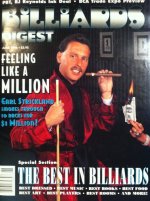For the million dollar challenge, the matches were to 15. If you break and run three racks from the flip and then miss, you will get another chance to run 10 unless your opponent runs out. Following up on the article I posted, if in fact it were 40% for a run-out, the chance would be 1/10000 from the first flip. But it's more likely than that because Earl played more than one match and the matches were to 15.
Whether 40% is the right number is a good question. Look at the Accu-stats statistics from the 1980s. The newsletters with great steaming piles of stats used to be on AZB but I can't find them now. The originals are here:
http://www.sfbilliards.com/accustats/index.html
Great! I would have loved to have this article back when CJ and his minions were telling me I was clueless when analyzing Earl's Million Dollar run. :angry::wink:
Anybody trying to predict the outcome of an event by using statistics has only the existing data to work with. This data may be only a small sample, it may be incomplete and inconsistent, or it may even have been recorded improperly.
However, assuming there actually was a very large data set gathered over numerous tournaments over a long period of time, it would be reasonable to use the B&R average to make this prediction. Given that the stated odds of running ten racks of 9-ball in a row at that time were 7.8 million to 1, the statisticians would have had to use the odds of an average pro having a B&R on any single rack to be approximately 20.45%. IOW... 1/.2045^10 = 7,800,000 to 1.
Since 20% it is not far off what we might assume as an average long term B&R average among all pros, this estimate that the chance that some random pro will run 10 racks in a row seems to be good at first glance. But there are many other things to consider.
First, the race was to eleven, not ten. A player could run either the first ten games of the set or the last ten and still achieve the 10 pack. That lowers the odds substantially. Earl ended up running 11 in a row. Using the same B&R percentage that was used for calculating the chances of 10 in a row, the chances of anybody running 11 in a single trial would now be 38 million to 1!
Second, it wasn't the only match that would be played. The million dollar bonus was to be awarded to any player that ran a 10 pack, not just Earl. Many players, numerous matches, and several tournaments worth of play means that the chances are much greater than if a single attempt was made.
Third, the statisticians weren't just using Earl's B&R average. If they had, the odds would have been much lower, because Earl's B&R would probably have been closer to 25% at the time.
Fourth, the stats were calculated with the a priori assumption that B&R averages would be relatively static. They had no way to know that many players such as Earl would attempt to develop specific strategies that increased their chances of running the 10 racks. Earl, for one, was said to have done this ahead of the tour.
Fifth, Earl was going for the big brass ring. There would be no safety play, that would just ruin the run. He had to pull out all stops, even if it reduced his chances of winning the actual tournament. Under these conditions, every shot suddenly looks makable in some way, dramatically increasing your chances of pulling it off. It was under just such conditions that SVB supposedly ran 14 racks of 10-ball in practice. The odds against that happening during actual tournament play are... well, too great to imagine.
I hope Bob's article puts the notion to rest that Earl faced astronomical odds in his quest for the million bucks. They were certainly not even money, but so much better than 7.8 million to one that continuing to cite that figure as a measure of the magnitude of his accomplishment is humorous at the least.
